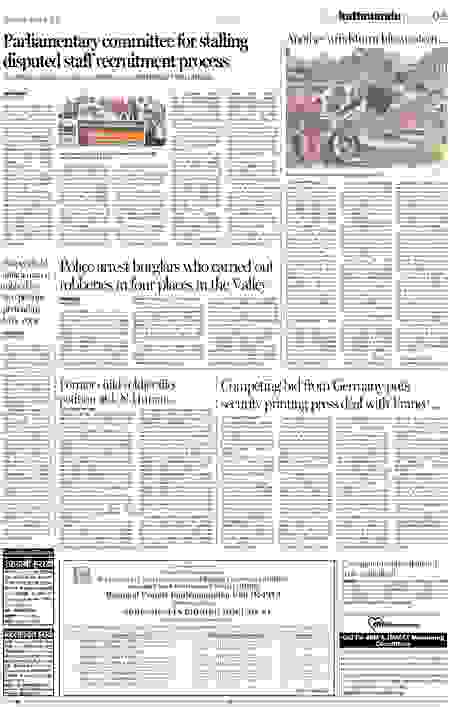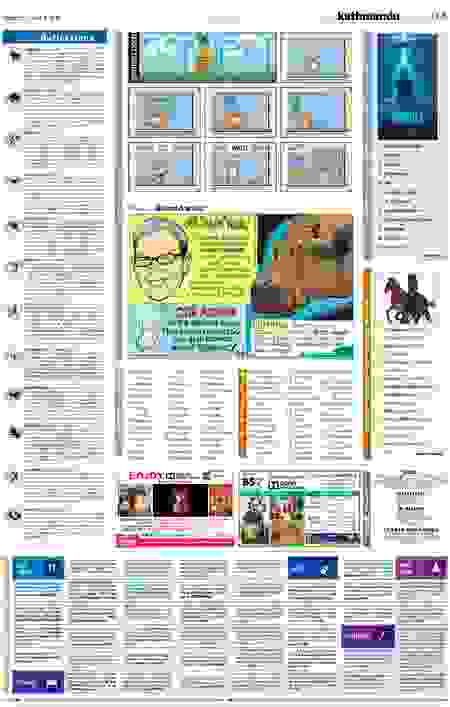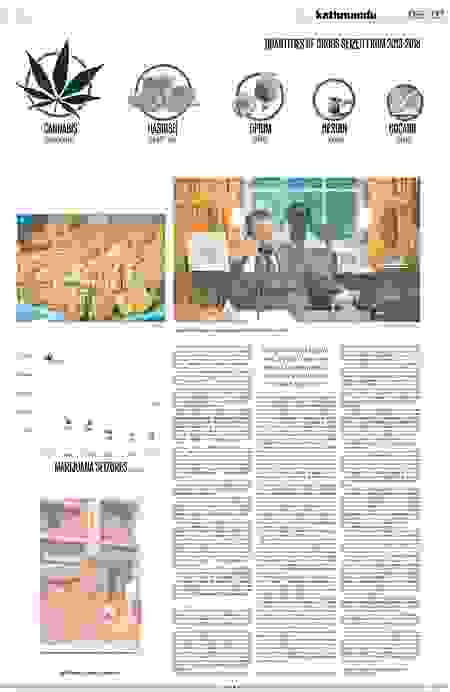YES WE CANNABIS

With countries around the world pursuing marijuana legalisation, many in Nepal are wondering if it too should consider government regulation.Photo courtesy: the.stoned_photographer
KATHMANDU : Tucked between two homes in a corner of Patan is a small but vibrant garden. Its caretaker, 37-year-old Nirakar, is an unlikely gardener in Nepal, tattooed and dreadlocked. But given the kind of herbs he grows, Nirakar is society’s ideal.
“When people look at me, they misunderstand me,” says the 37-year-old. “It’s the same thing with my plants. They are just misunderstood.”
Nirakar grows Cannabis indica, the most abundant marijuana strain in Nepal, which he puts up to dry alongside his mother’s garlic and ginger for his own consumption. But unlike his mother’s herbs, the kind he grows could cost him his freedom.
If caught, the amount of processed cannabis in his possession could earn him up to three years in prison, with fines of up to Rs 25,000, as per the Narcotics Drug Control Act 1976.
Yet, despite the risks, Nirakar publically broadcasts his love for the plant to the world through several of his social media platforms, including his YouTube channel, which has over 11,000 subscribers, and his Instagram account, ‘the.stoned_photographer’.
“Having this might be illegal,” says Nirakar, who spoke on condition that we use his first name only because of fears that his involvement in the story would affect his family. “But marijuana is the reason I was able to recover from my battle with drug addiction. It continues to save my life, so why should I have to hide it?”
In the early 2000s, Nirakar was addicted to hard drugs including heroine, and he credits marijuana with helping cleave him of his addiction. While many in Nepal continue to see marijuana as a public nuisance and a ‘gateway drug’, for people like Nirakar, ganja is therapeutic, helping them kick addiction. The latter voices—encouraged by an ongoing global push for progressive research and legislation to consider cannabis’ medicinal benefits—are now finding more sympathetic ears in Nepal.
“In drug rehabilitation programmes, a typical route prescribed to recovering addicts is ‘total abstinence’,” says Rajiv Kafle, another recovering addict. “For addicts diagnosed with HIV—who form a sizeable number—depression, suicidal thoughts, and a lack of meaning in life are very common. So why not point users to substances that are relatively less harmful in their path to recovery from addiction?”
Like Nirakar, Kafle has long been vocal about his endorsement of the plant that helped wean him off of harder drugs. But Kafle also lives with HIV, and he says marijuana continues to help him with the side effects of antiretroviral therapy—nausea, lack of appetite, and insomnia. The plant’s THC—tetrahydrocannabinol, the chemical responsible for a majority of marijuana’s psychological effects—and CBD—cannabidiol, a naturally occurring compound found exclusively in cannabis—have made ‘life-changing’ interventions in his recovery, Kafle says.
For nearly a decade, 50-year-old Kafle, who lives in Bangkok, has been advocating for a re-evaluation of the plant’s social and legal perception as a ‘hard drug’.

“When I first raised the issue back in 2010, very few people were willing to publicly talk about cannabis legalisation in a serious manner,” says Kafle, who primarily campaigns online through his Twitter handle @RajivKaflay and the hashtag #LegalizeNepal. “But living with an HIV diagnosis has built my immunity to stigma.”
Focusing on medicinal legalisation, particularly for people living with HIV in Nepal, Kafle has a seemingly lofty goal: legalise cannabis in Nepal by 2020. Despite being met with dismissive laughs, his efforts—from posting informative statuses, reporting about arrests and seizures related to cannabis, and engaging with the government on issues related to legislation through social media—were never blunted. As his self-imposed deadline approaches, people are not laughing anymore, he says.
A thorny question
In the budding cause for legalisation, Kafle has been joined by other Nepalis dispersed around the world who are asking similar questions.
Some have taken to creative outlets to challenge the stigma around the recreational consumption of cannabis. YouTube is rife with examples—Chirag Singh Khadka’s (5:55) ‘Budi’, a lovesong to marijuana that quickly went viral after it was launched in February, is one popular example.
But the movement gained an unexpected supporter earlier this year on February 20, when Birodh Khatiwada, a lawmaker from the ruling Nepal Communist Party, raised the issue of cannabis legislation in the House of Representatives. Pointing to its potential to become a lucrative cash crop and create employment opportunities, especially among rural farmers, Khatiwada’s interjection has furthered discussions on legalisation among state officials.
“Nothing has happened on the legislative level yet, but there have been some informal discussion in the upper levels of government,” Khatiwada told the Post. “The response from the party was not negative. Some of my fellow parliamentarians wanted to approach the topic long ago, but did not do so for various reasons.”

The renewed debate over whether or not cultivation and consumption of cannabis should be legalised in Nepal comes at a time when a number of countries around the world—from Canada to South Africa to Thailand—have legalised cannabis, either for medicinal or recreational use or both, under a regulatory framework. And with more research into the plant’s medicinal values also being conducted, governments around the world are confronting the thorny question of legalisation.
In Nepal, cannabis has long been a part of many medicinal and cultural traditions. But despite this long and storied history, the cultivation and consumption of marijuana remains illegal, punishable by harsh jail terms and steep fines.
For young, connected people like Nirakar—his brother-in-law is an influential politician—the Narcotics Drug Control Act 1976, in many ways, is merely an inconvenience. But for those without his resources and connections, the Act holds entirely different consequences.
Farmers from across rural Nepal and their families, brokers, middlemen, and youth caught within the illicit drug trade have felt the blunt end of the Act.
According to statistics provided by the Narcotics Control Bureau, cannabis is consistently its most-seized substance. In 2018, 4,181 kg of cannabis, 1,546 kg of hashish, 8 kg of heroin, and 2 kg of cocaine were seized from across Nepal—a slight rise on all accounts from the previous fiscal year. While the Nepal Police said that they do not have official data that identifies how many arrests were related to cannabis, they noted that the number of drug-related arrests in general has risen sharply in recent years—by 83 percent since 2013.
That a culturally significant plant is regulated by a harsh law has led to numerous incongruous examples throughout the Act’s four-decade-long history.

During the Maoist insurgency, for example, the ganja market was regulated by cadres in some areas of Nepal. As evidenced by a confidential US cable titled ‘Nepal: Mid-Year Status Report on Drug Trafficking’ published by WikiLeaks in 2003, Maoist insurgents in the middle hills of Nepal would regularly levy taxes on both the cultivation and transportation of cannabis. The report estimates that the levy was as high as 35 percent of the value of crops.
Across Nepal, from the hills of Rolpa and Rukum—where the Maoist insurgency was born—to the eastern plains, marijuana cultivation, though farmed by locals, is now largely controlled by a cross-border nexus of political figures, armed mafia and drug smugglers.
There is a clear nexus in the market, says Kanchan Jha, founder of Sano Paila, an organisation that runs, among other social interventions, a leadership programme for youth in Birgunj recovering from drug addiction. In Parsa district, the ones who get arrested aren’t the people at the top, he says. Farmers and brokers, many of whom are youth, only get one percent of the cut but face a majority of risks.
“There was and still is so much violence in the trade, especially in Parsa, and many youth and farming communities are simply caught in the middle,” Jha says.
Parsa’s history is entangled with cannabis and poppy cultivation. According to a 2015 article in the Nepali Times, it accounted for 60 percent of its arable land before 2011.
The District Police Office in Parsa told the Post that in the past year, 63 people had been arrested for smuggling marijuana and hashish. As clashes between marijuana smugglers and police often result in armed exchanges, the District Police Office has sought to up the ante on combating drug smuggling.

“The risk of legal persecution depends largely on who you are and where you buy from,” says a 20-year-old marijuana dealer in Kathmandu who refused to give his real name and asked to go by Babaji, the name he gives his buyers. Kathmandu is hundreds of kilometres from Parsa and the Indian border, where most of the smuggling takes place.
“There are popular spots and cafes in Basantapur filled with Nepali youth smoking weed,” he says. “The police do not care. But if the same place was elsewhere, somewhere outside Kathmandu, things might be different.”
Babaji, who estimates he has around a hundred customers, procures his supply from villages surrounding the Valley—including Dhulikhel, Phulchowki, Budhanilkantha and Tarebhir. He makes ‘hunting’ trips every weekend and claims to make Rs 7,000 a week on average. Others, especially those who rely on cannabis sales as their primary source of income, make much more, he says.
But Babaji’s homework—he is currently a master’s student in Public Health—causes distractions.
“I face little to no risk doing this job. Many of my friends also go out [cannabis] hunting and sell to make money on the side—but maybe not as much as I do,” he admits. “It is really easy. But it really depends on who you are and what kind of connections you have.”
For one 43-year-old Pokhara-based dealer originally from a village in Hetauda, things are a little different. Though his family engages in cannabis-farming on the outskirts of their home district, he regularly frequents Pokhara’s Lakeside in search of tourists and high-paying customers.
“If I get arrested, my family will not eat,” says the Pokhara dealer, who asked to be identified as Vishnu, also a pseudonym, because he feared getting arrested. “But my customers, the ones who ask for large amounts to sell themselves, will not be punished. Someone needs to get punished and at the end of the day, it will be small people like us.”
According to Vishnu, legalisation will not dismantle the existing nexus in the transnational marijuana market, especially in Nepal where corruption is rampant.
“The only market I care about is one where those at the top and those at the bottom like me are on the same level,” he says. “I don’t care about legal or illegal. I want equality, a fair chance, and food for my family.”
The discrepancy that Vishnu points to is largely a result of ambiguities and contradictions in the Narcotics Drug Control Act itself, say experts. For example, advocate Subash Acharya argues in a 2016 article that the Act’s failure to draw distinctions between casual drug users, hardcore addicts, petty drug peddlers and seasoned traffickers encourages an environment of disproportionate and irregular prosecution.
And the lengthy history behind the Act itself is a controversial one, as some argue that it was shaped by a series of strains that had very little do with Nepal.
A strained history
With eyebrows furrowed, Rabi Raj Thapa, a retired Assistant Inspector General of the Nepal Police, scans through the Narcotics Drug Control Act. As a founding member of the Nepal Police’s Narcotic Drug Control Law Enforcement Unit in 1992, Thapa is no stranger to the document.
“Everytime I read it, I notice something else that seems unclear. See here,” he points at the document and says, “the act puts ‘medicinal cannabis’ and ‘cannabis’ in different categories but labels both as a ‘narcotic’. What is ‘medicinal cannabis’? How is it a narcotic and why isn’t it defined?”
According to Thapa, the ambiguous treatment of cannabis by the document largely stems from the fact that the act was not drafted on Nepal’s terms.
The criminalisation of marijuana is largely a foreign imposition—from the then Richard Nixon-led United States administration’s ‘war on drugs’, according to Thapa.

“It seemed to come out of nowhere,” says Thapa. “Suddenly, a plant that grew abundantly across the country, that was used to treat stomach aches even among young children was placed under the same category as heroin and cocaine.”
In the chapter 'Cannabis in Nepal: An Overview', written in 1975, James Fisher discusses the series of pressures exerted on the Nepali government to crackdown on cannabis in the early 70s. According to Fisher, when hippies from Western countries flocked to Nepal in the late 60s and 70s as part of the overland hippie trail, they brought with them a market and commercialised demand for the country’s marijuana and hashish.
Afraid that Nepal was becoming a major contributor to the transnational drug trade, the United States government saw to it that Nepal’s legislation discouraged drug use, or ‘public enemy number one’, in Nixon’s terms, especially among some of its youth who had used Nepal as a haven to escape the draft during the Vietnam War.
With the greater demand for cannabis, the price of charas (cannabis concentrate) skyrocketed—from about $15 per kilogram to $70. In an attempt to regulate the growing market, the government had already enforced the Intoxicants Act of 1961 and the Intoxicants Rules in 1962, making it mandatory for farmers seeking to cultivate cannabis commercially to obtain licenses.

While there is a lack of concrete historical documentation to undeniably implicate the US government in the plant’s criminalisation in Nepal, historians and politicians over the years have pointed to past examples of US-led pressure to encourage Nepal to adopt stricter drug laws.
For example, Bhekh Bahadur Thapa, finance minister at the time of the ban, recently told the Annapurna Express that “the US government threatened, if in not so many words, not to recognise Birendra Shah’s ‘authoritarian rule’ in order to force him to ban cannabis.”
According to Fisher, the government began regressing from its progressive stance on marijuana on July 16, 1973, when an ordinance was issued to revoke all licenses to “cultivate, ban, and sell marijuana.”
The crackdown on the marijuana market in Nepal was supplemented three years later by the Narcotics Drug Control Act 1976, which--at least on paper--criminalised the “sale, cultivation and consumption” of cannabis.
But the history is hazy. While licenses were supposedly revoked and marijuana was legally declared a ‘narcotic’, subject to stringent control, the time period in which the ban was legally enforced among local populations is ambiguous.
“Narratives on marijuana’s history in Nepal cannot start with the hippies nor can it end with the Narcotics Control Drug Act,” says Abhi Subedi, a historian at Tribhuvan University. “Though the ban was introduced in 1976, consumption continued among locals. The difference was that despite the ban, a transnational illicit trade market for the drug had grown--and it continued to find protection.”
The ambiguity also stems from Nepal’s delayed accession to the 1961 Single Convention, an international treaty that prohibited the production and supply of narcotics and formally classified cannabis as a Schedule IV drug. Under this category, the plant was now subject to more stringent international control and clubbed together with heroin, cocaine and opium.
Though Nepal eventually acceded to the Single Convention in 1987—nearly a decade after India and two years after China—it did so with a reservation that included the “right to permit temporarily” the “use of cannabis, cannabis resin, extracts and tinctures of cannabis for non-medical purposes” without a specified end date.
According to Kafle, the omission of an end date was highly strategic and could be seen as an example of early resistance against the criminalisation of marijuana.
“Nepal was the last country to defend marijuana’s medicinal values in the international arena,” Kafle said. “Because nobody objected to Nepal’s reservation, a review by the World Health Organisation should have been held to consider our claims.”
The necessary review Kafle refers to was finally concluded on January 24, 2019—three decades after Nepal’s reservation and one week before Birodh Khatiwada address in Parliament—when the World Health Organisation’s Expert Committee on Drug Dependence (ECDD) recommended that cannabis be removed from the Single Convention’s Schedule IV and be placed under Schedule I, citing recent research that “highlighted its medicinal values.”
Forty-three years after the ban was instituted in Nepal, the context has virtually flip-flopped.
The very system of governmental regulation of cannabis through the issuance of licenses, which Nepal was pressured to abandon, is now being encouraged by the same countries that were once at the forefront of marijuana’s criminalisation.

Joint benefits
It is largely due to this storied history that the Narcotics Control Act 1976 is riddled with ambiguities and and contradictions—some of which have made for tangible entry-points to talks on legalisation.
Several activists point to various legal loopholes in the Act that provide space for the usage of cannabis for medicinal purposes. For example, Article 5 (a) stipulates that the “purchase and consumption of narcotic drugs by any person in the recommended dose from any licensed shop on the recommendation of any recognised medical practitioner for the purpose of medical treatment...shall not be deemed to have been prohibited”.
While seemingly disjointed from and contradictory to other sections of the Act, the provision has been used to justify Oral Substitution Therapy programmes under the Home Ministry, wherein minute doses of drugs such as methadone or synthetic opioids are prescribed to those recovering from drug abuse and addiction. But no regulatory mechanisms or directives to carry out this provision for cannabis, which falls under the category of ‘narcotic drugs’, have been passed or discussed on a legislative level—even though the Act has been amended five times in the past 46 years.
“Studies have shown that for those living with HIV, cancer patients, those with chronic illnesses, and people recovering from a history of drug abuse, cannabis can play a transformative role in treating mental and physical pain,” says Kafle. “If our history and the law itself points to the use of cannabis for medicinal purposes, why can’t we provide a mechanism to enforce it?”
According to Dr Binod Sah, a production officer at Singha Durbar Vaidyakhana, Nepal’s oldest government-run ayurvedic medicine manufacturing company, the legalisation of cannabis could lead to new avenues for profit. Contrary to claims made by Khatiwada in his parliament address, Sah maintains that the Vaidyakhana “neither exports nor imports any cannabis products or essence” but stands to gain much if it is legally able to capitalise on the plant’s medicinal values.
“The ban does, to some extent, limit our capacity to maximise profits,” he says.
Beyond the ayurvedic industry, others point to legalisation’s role in Nepal’s economic development. According to Michael Sautman, a leading expert in producing standardised cannabis products on an industrial scale in regulated environments, Nepal could benefit immensely from the legal cannabis industry, which is expected to reach $146.4 billion by 2025. But time is of the essence.
“With new countries entering the global cannabis industry, the market risks saturation,” Sautman told the Post in a Skype interview. “By joining the industry, Nepal will create thousands of employment opportunities.”
Sautman adds that Nepal is uniquely situated. While other countries may have to start from zero to cultivate a brand and gain recognition, Nepal is far ahead: a brand exists, thanks to Nepal’s global reputation as a hippie haven. The genetics of many Nepali strains are found in hybrids around the world today, Sautman says. The country merely has to cash in.
But for Thapa, the calls for legalisation feel frustratingly familiar.
“We succumbed to international pressure when we rushed to enforce a Narcotics Control Act that wasn’t adapted to our country’s context—that wasn’t on our terms,” he says. “There is no rush and we shouldn’t jump into the market immediately.”
A homegrown way forward
According to Chakra Raj Joshi, a superintendent of police at the Narcotics Control Bureau, the government is “currently working to draft a new law regarding legalisation” but said “he could not elaborate any further.”
“Legalisation of marijuana is a sensitive issue and needs much thought before taking any steps,” says Joshi. “I have argued that instead of legalising marijuana, there should be additional punishment to the perpetrators. The number of marijuana users has been on the rise, but there hasn’t been any significant change in terms of punishment since the 1976 act. So more stringent punishment might discourage the use, farming and business of marijuana.”
He especially pointed to legalisation’s impact on further drug consumption among youth, who form a majority of consumers. In 2016, the Narcotics Control Bureau told Republica that 75 percent of drug users are aged between 15 to 30 years, according to admission trends at rehab centres. The primary substance within this group was found to be cannabis and hashish.Sautman, however, says that research suggests otherwise.
“Legalisation and more progressive drug laws could encourage those who are now operating within the illicit drug trade to come under the tent of a regulatory system. This is what we’ve seen in countries like Colombia,” he said. “The theory of marijuana being a ‘gateway drug’ and thereby encouraging further drug use has received less credence in the marketplace of ideas.”
A necessary prerequisite to any further talk is a feasibility study that examines the impacts of legalisation in Nepal’s context, says Thapa. By answering fundamental questions—such as how the consumption and trade of marijuana has evolved in recent years, how that evolution has impacted the country, and how the larger public feels about the issue—the discourse on legalisation can be supplemented with much-needed research rooted in Nepal.
“Everyone points to ‘research’ but how many studies have been conducted here?” asks Thapa. Thapa also points to another concern: the need for a protective apparatus to ensure that the market is not inundated by the interests of large foreign corporations.
Similar concerns were expressed when the Government of Thailand amended its 1979 Narcotic Act, legalising marijuana for “medical use and research” in December 2018. In response to fears that the market would be dominated by large-scale foreign firms—two of which had already sought patents shortly after legalisation—the Thai government decided to revoke all patent requests under the premise that “a plant cannot be patented”.
Such actions offer a blueprint for relatively smaller countries like Nepal seeking protection from the growing presence of powerful corporations. But Thapa remains skeptical.
For him, the key to a successful way forward are home-grown solutions and, most importantly, dialogue to hash out remaining concerns in the legalisation movement.
“At the end of the day, our approach to legislation—when or if we decide to take that step at all—has to be led by Nepal and Nepali concerns,” Thapa said. “It doesn’t matter who has legalised already or what the international market is doing. What matters most is that we see both sides of the coin. Who stands to gain and who stands to lose?”
Timothy Aryal and Asmita Manandhar contributed reporting.


























































